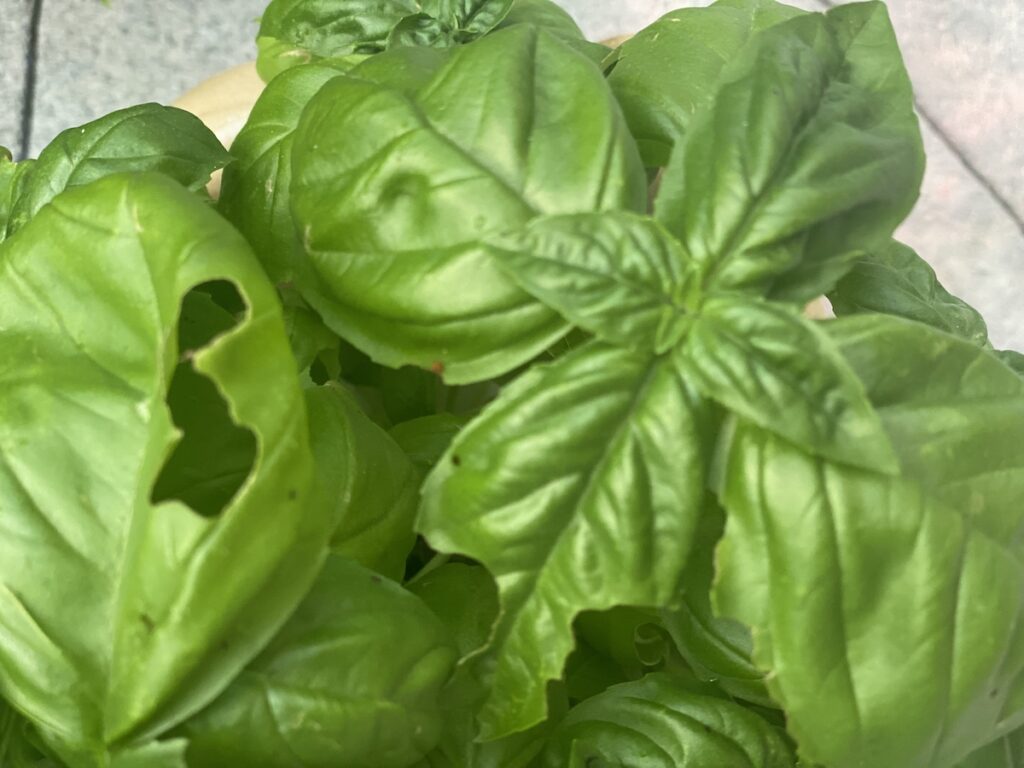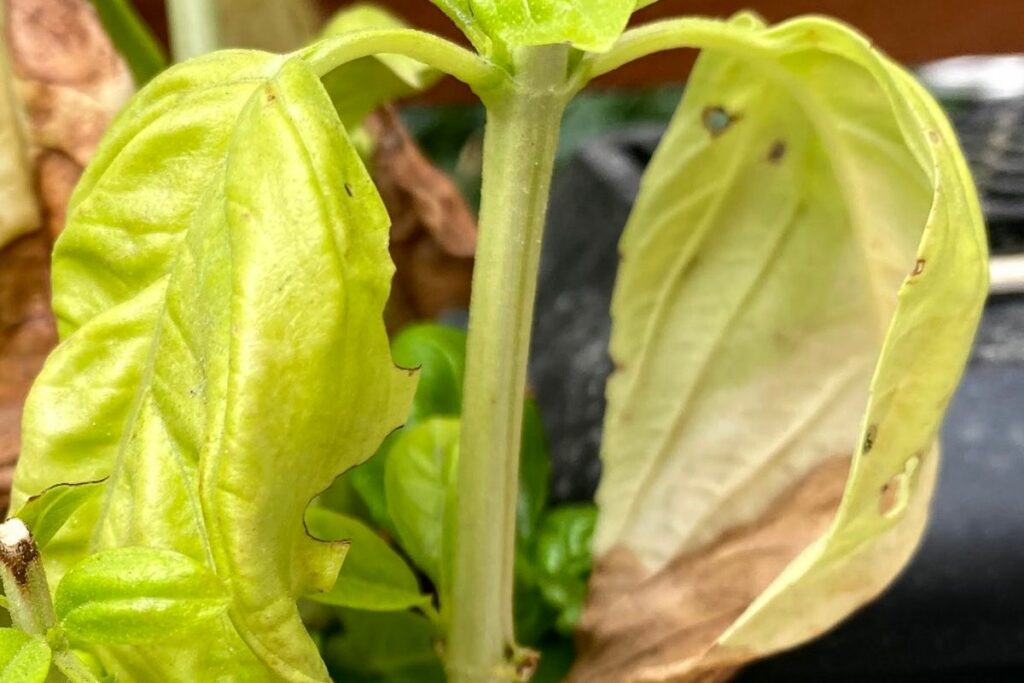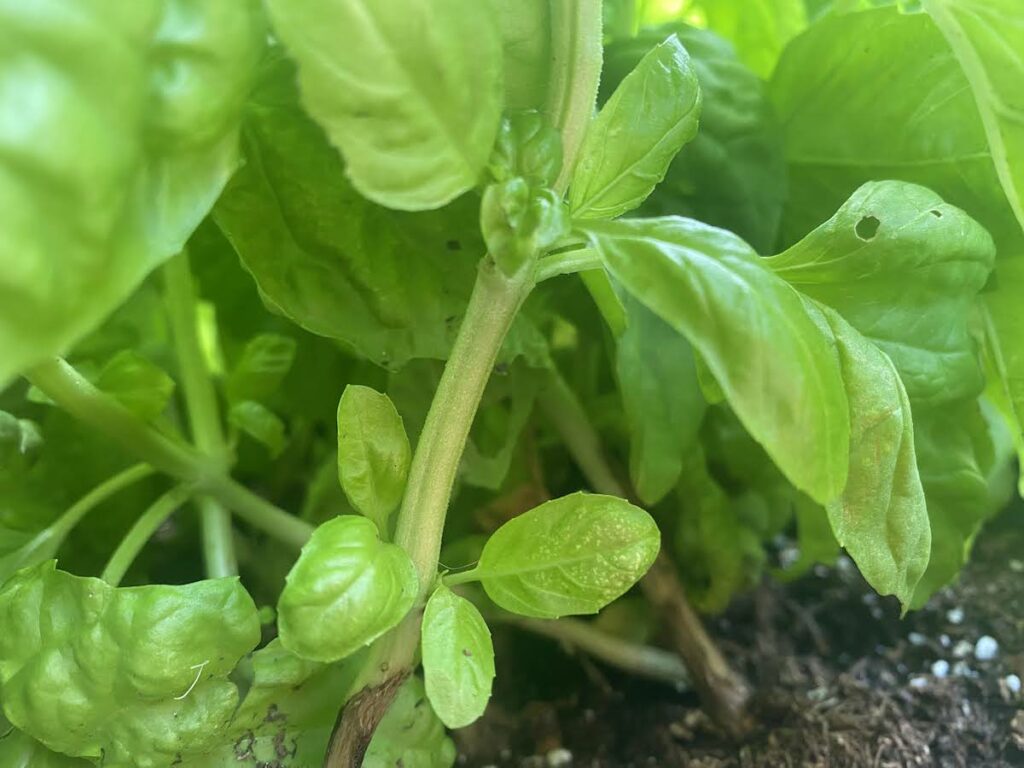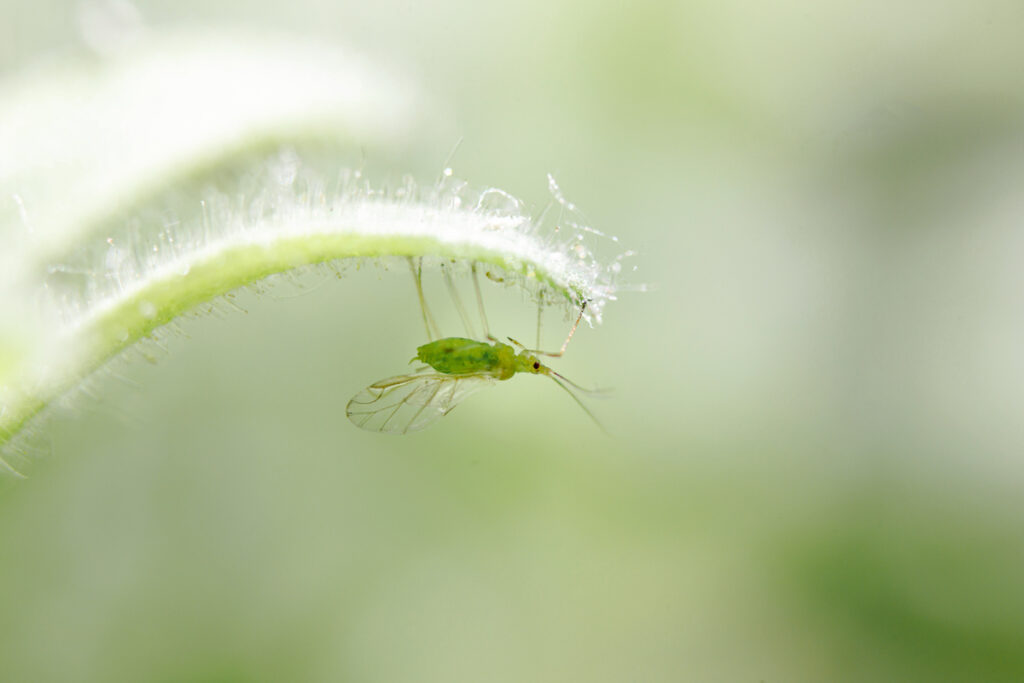As an Amazon Associate I earn from qualifying purchases. This website also participates in other affiliate programs and may earn commissions if you shop through the links used on this website.
(This article was originally published on August 11, 2021 and was last updated on September 15, 2022)
Has your basil plant been looking a little bit worse for wear lately?
Maybe you’ve noticed small holes (or large ones) in your basil leaves. Or some yellowing of the plant.
Or maybe you’ve caught a critter in the act, making a nice lunch out of your delicious basil leaves or even the flowers and buds … and stealing your pesto ingredients or pizza topper right out from under you.
If you look closely in this photo below, you can see a tiny red spider mite at the bottom of one of the leaves…perhaps it was responsible for the massive holes in these leaves?

If you suspect an insect is eating your basil plant, you’re probably anxious to find and fix the problems. Below, I’ve listed some of the most common reasons for holes in basil leaves, as well as some clues to help you answer the all important question, what is eating my basil?
Finally, I also offer some tips: how to fix holes in basil plants, and how to prevent holes in basil leaves from happening again, so you get a nice harvest and maybe even some seeds to grow next year!

More Than 7,000 People Can’t Be Wrong!
For one-off problems with your basil or herb garden, a quick Google to solve the problem is great.
But if you want more help getting the herb garden of your dreams, mastering cooking with basil, or other creative uses of basil, Skillshare has some awesome herb-related courses (plus a ton of other interesting, useful and cool courses).
To date, more than 7,000 students have taken Indoor Gardening: Grow Houseplants, Veggies, and Herbs!
Normally Skillshare Gives A 7-Day Free Trial. You Get A 30-Day Free Trial (OR 30% Off An Annual Membership)
Our friends at Skillshare have graciously offered our readers an extended free trial, using this link here to sign up. Instead of 1 week to try out all their courses, you get a full month to try courses like:
- Indoor Gardening: Grow Houseplants, Veggies, and Herbs // (use this link to get a 30-day Free trial) // (use this link to 30% off an Annual Membership)
- Create a Small Space Edible Garden // (use this link to get a 30-day Free trial) // (use this link to 30% off an Annual Membership)
- 5 Easy to grow herbs, sowing, growing and harvesting // (use this link to get a 30-day Free trial) // (use this link to 30% off an Annual Membership)
- Crafting Infused Tea: Herb, Flower, and Fruit Iced Teas // (use this link to get a 30-day Free trial) // (use this link to 30% off an Annual Membership)
Sign up for a FREE 30-Day Trial (this link only)
Or Save 30% Off An Annual Skillshare Membership
If you know you’re going to love Skillshare, you can also sign up for an annual membership and save 30% with this link.
What Pests Eat Basil Plant Leaves?
Just as people love the fragrant, delicious taste of basil plants, so do a number of pests. Japanese Beetles, slugs, aphids and more – some pests are more likely than others to snack on basil plant leaves!

If you find holes in basil leaves, be on the lookout for snails, aphids, whiteflies, fourlined plant bugs, Japanese beetles, slugs, and caterpillars. They’re some of the more likely culprits.
If you’re not sure which pest is damaging your basil plants, you’ll need to inspect the plants. Once you identify what type of pest or insects are causing the issue -either by seeing the insects on your plants, or recognizing the damage left behind – you can follow the tips below to get rid of them, and get back to gardening.

Slugs and Snails
It’s easy enough to identify these pests if there are slugs or snails actually on your basil plant. But it’s harder know if slugs or snails are the culprit if they’ve already left the scene of the crime.
Look for large, uneven holes on the plant leaves. This type of uneven hole is fairly characteristic for these pests, and is a good sign they could be responsible. (However, black spots, white spots or brown spots on basil that turn into holes could be a fungal or bacterial infection).
Slugs and snails also tend to eat basil at night. If you notice a lot of the leaf damage is happening over night, it’s a strong sign that it’s a slug or snail snacking on that precious basil leaf.
How Can you Protect your Plants from Slugs and Snails?
Beer is a commonly suggested trap for slugs and snails. Indeed, if you put a small dish of beer near the plant, inset in the soil or nearby, you’ll most likely catch and kills some slugs.
However, I’d caution against this type of trap. The smell is so attractive to these pests, it can actually end up attracting more slugs to your garden, which defeats the point. These traps are also dangerous for other critters, and may kill beetles, related but beneficial slugs, or small animals such as hedgehogs.
A better option is wrapping a wide band of copper foil or tape around your planter. Copper is effective at repelling slugs and snails, and offers a no-kill solution that won’t accidentally trap beneficial insects or animals.
If you find the copper tape doesn’t work, you could also rub a generous layer of Vaseline around the outside edge of your basil pot, and then cover the Vaseline with salt. The salt dries out the slug when it tries to cross the barrier, and you may find they simply avoid trying to cross.
One challenge with the Vaseline and salt trap is rain: rainy days will wash it away, unless it’s under the cover of a plant pot rim.
It should go without saying, but just in case: you should also try to physically remove them if you see a snail or slug on a basil leaf!
Japanese Beetles
My kid calls these little insects rainbow beetles, because they’ve got a metallic, “rainbow in an oil slick” look to them.
You usually find Japanese Beetles throughout the late spring and summer, which is coincidentally right when you’ve got your basil plants growing outside. Summer is peak season for growing large, fragrant and bright green leaves!
If you find your basil leaves left as a skeleton – i.e. insects have eaten the tender part of the plant leaves, but left the veins alone – it’s a good clue it was Japanese Beetles that ate your basil, rather than other insects.
Japanese Beetles eating holes in your basil are often easier to identify than slugs and snails because they eat during the day, and like to eat veggies and herbs. In other words, you’re more likely to catch them in the act, while they’re snacking and making a new hole on your herbs!
One of the best tips to control these pests is using Neem oil.
Neem oil is from the Neem tree, and since it’s natural, it’s safe to use on edible herbs (although you should always double check the label of the product you’re using, and always give your herbs a thorough wash before eating). I like it because it’s a natural, organic and green way to help control Japanese Beetles.
However, you’ll also want to be on the lookout to catch each beetle in the act. If you do see one, physically pick it off and kill it by dropping it in some soapy water.
Aphids

Aphids are another common basil pest. They are tiny, mostly translucent bugs that look either greenish or whiteish in color, and typically attach to the underside of a basil leaf.
These insects LOVE to feed on the tender leaves of basil. Once on the leaves, they feed by sucking the juice right out of the leaf. Not exactly a recipe for success if you’re growing delicious basil for your kitchen!
If you find yourself with an aphid problem, my first advice is to contain them as much as possible by blasting them off with your hose. While this probably won’t fix the problem entirely, it will protect the plant a bit and keep the infestation from getting too out of control.
To blast them off without damaging the plant or leaves, you need a strong jet of water that is also quite fine. Put your hose on the finest water spray level to start.
Blast the underside of the leaves, by holding the spray nozzle low, and angling the water up at the leaves. Once you’ve blasted the bottom of the leaves, being careful not to hurt the leaves themselves, search for any on the top of the leaves, and blast those off, too.
A more durable solution is to use ladybugs, which are natural predators to aphids, and can work as a sort of “nature’s insecticide.”
You can buy packs of live ladybugs online or from a local garden center. In the early morning or right around dusk (i.e., before or after the sun is at its full strength), sprinkle the ladybugs on your plant. The ladybugs will enjoy a nice meal of aphids, and keep the population low as they search for their next fresh meal.
Finally, Neem oil and insecticidal soap are two other options to consider.
You can buy insecticide soap from a garden center, or make your own by making a soapy water solution from pure soap, and adding an oil, such as coconut oil, in the correct proportions. It’s safe for basil plants, and suitable for organic gardening. Despite the name, it’s a safer solution than standard insecticide chemicals.
Whiteflies
If you have small insects on your basil plant and they’re not aphids, they might be whiteflies.
A crucial test is to rub or rustle the leaves of your basil plant. If a cloud of tiny insects come up when you agitate the basil leaves, it’s a sign you probably have whiteflies.
If you’re still not sure, check the leaves. If they have a sticky residue on them, that’s another clue you have a whitefly problem, as whitefly droppings leave a sticky residue (erm….yum, right?)
Once you’ve identified that it’s whiteflies eating your basil, the question becomes how to get rid of them.
Periodic and sparing use of insecticidal soap and Neem oil spray are both good options. While it won’t be as effective as a chemical pesticide, it’s safer for you and your garden, and still works by making the plant less attractive to pests.
You can also try vacuuming them off mature plants (don’t do this with any fragile basil seedlings you’re growing). Only use a small, low powered vacuum (such as a handheld, dust-buster style), and test first to make sure it won’t suck up all the leaves. Ideally you’ll also use an upholstery attachment to protect the leaves a bit more.
Four Lined Plant Bugs
Unfortunately, the Fourlined Plant Bug is attracted to basil, too.
Typically, these bugs exist in a geographical area spanning from the middle to eastern USA and southern Canada, and appear in Spring. The good news is, they have a fast lifecycle. They disappear as quickly as they appear, and are gone by mid-July.
They leave distinctive pockmarks on plants, and can leave small holes, as well. While annoying, the pockmarks don’t tend to actually damage the plant, although any holes they leave in the middle of the leaves will make that leaf inedible.
If you see reddish orange nymphs that turn into a striped, yellow insect, it’s likely a four lined plant bug.
The good news about these bugs is they’re only around for a month or so, before disappearing for the season. Even better? As noted above, the damage is mostly just aesthetic.
If you want to try to get them off your basil, it’s helpful to know these bugs are very attracted to mint. You can plant mint to attract them away from any other plants they may be on, and then regularly pick them off your mint plant. This strategy will help keep them away from your basil!
Because the damage is mostly aesthetic, your best bet is to try to remove them (ideally when they’re nymphs) and then just wait for the season to end.
Spider Mites
Spider mites are another common basil annoyance. And like aphids, they suck the juice right out of the leaves and veins, leaving light spots on the leaves where they eat, and causing the leaf to then turn yellow or brown. While small numbers of spider mites aren’t typically a huge problem, larger infestations can kill the plant.

First, you need to figure out whether you have a spider mite problem. Look for tiny black (or red) dots that move or little cobwebs, often on the underside of the leaves. If you have a number of leaves that have fallen to the soil, take a look through them as well, as spider mites sometimes hide in the fallen foliage.
These insects tend to infest basil plants that are under-watered and wilting, or generally stressed for other reasons, such as inadequate space for the root system, so keeping up a regular watering routine and ensuring your plant gets adequate sunlight is important for prevention.
Blasting them off with a hose – the same method you’d use with aphids – is a good first step if you have an infestation. Neem and insecticidal soap can also help.
What About Caterpillars?
Whereas insects can be controlled with physical and insecticidal methods, if caterpillars are eating your basil, you might want to create a physical barrier.
Tulle fabric is perfect for this, and will prevent the caterpillars from accessing your plant. Simple create a net with the fabric, and you’ll hopefully keep them out!
You may also want to encourage natural caterpillar predators into your garden – namely, birds. Add a bird house and feeder, and you may find your caterpillar problem goes away rather quickly!
FAQs
Should I Bring my Basil Indoors?
If your plant currently has pests on it, you’ll want to get rid of them before bringing it into your home. However, once you’ve gotten rid of the pests, you might want to bring your basil from your garden indoors in order to give it time to recover, or if you’re approaching the end of the growing season and first frost, and plan to move it inside for winter anyway.
Remember, basil needs consistently moist soil and plenty of sun – about 6 hours per day. Find a sunny windowsill in your house to place your basil when growing inside your house.
If the basil is already damaged and you’re bringing it indoors to help it recover, consider the temperature difference between your garden and your house. Basil doesn’t tend to do well with substantial changes to growing conditions, and bringing it in your house may actually cause further stress, if there’s a huge temperature difference.
What to do with Damaged Basil Leaves with Holes
Get rid of plant leaves with holes, even if they’re fairly small holes only.
This is a bit of a gross PSA, but if an insect has been on your plant to eat, it may also have decided to lay some eggs, which you don’t also want in your salad or pesto!
Even if they are small holes, remove any leaves that have holes. Typically, they’ll die off if you leave them, so removing them just hastens the process. You can prune stems that have a lot of damage, as this will encourage the basil plant to grow back stronger, bushier, and healthier, resulting in a better harvest and more plant growth.
If a leaf doesn’t have holes but looks damaged, remove those ones too. Search for brown and yellowing leaves, really dry or brittle leaves, or anything that’s rotting and unusually moist, or smells atypical. Look for any sign the leaves are unhealthy, and remove with gusto!
Finally, don’t use stressed plants to get cuttings that you plan to propagate. Only use healthy, mature plants for propagation!
Final Thoughts
Basil is fragrant and delicious, so it’s easy to understand why some insects like to eat basil, just like us!
The best defence against pests for your basil plant is actually a good offence! Keeping your basil plant healthy and strong means the plant will fend off pests better.
Once you do notice damage on plant leaves, act quickly to identify which pest is eating your basil, and work to find a solution.
That will get you back to herb gardening quicker, and allow you to enjoy the fruit of your labor!
Below, you’ll find a quick summary of this article and my tips.
How do I get Rid of Pests on my Basil Plants?
Whether you’ve got Japanese Beetles or Spider Mites, or something in between, here are a few general tips for controlling a pest infestation on your basil plant.
- Try to physically remove them. This may involve picking them off with your hands, spraying them off with a fine mist from a hose, or even gently vacuuming the plant.
- Introduce natural predators to your garden, such as birds or ladybugs.
- Use a spray such as Neem oil or insecticidal soap if needed,
- Keep your plants healthy with regular watering and pruning, adequate drainage, and lots of sunlight.
- Bring them inside if needed, but be aware the quick change in conditions could stress them further, so try to make a gradual transition.
